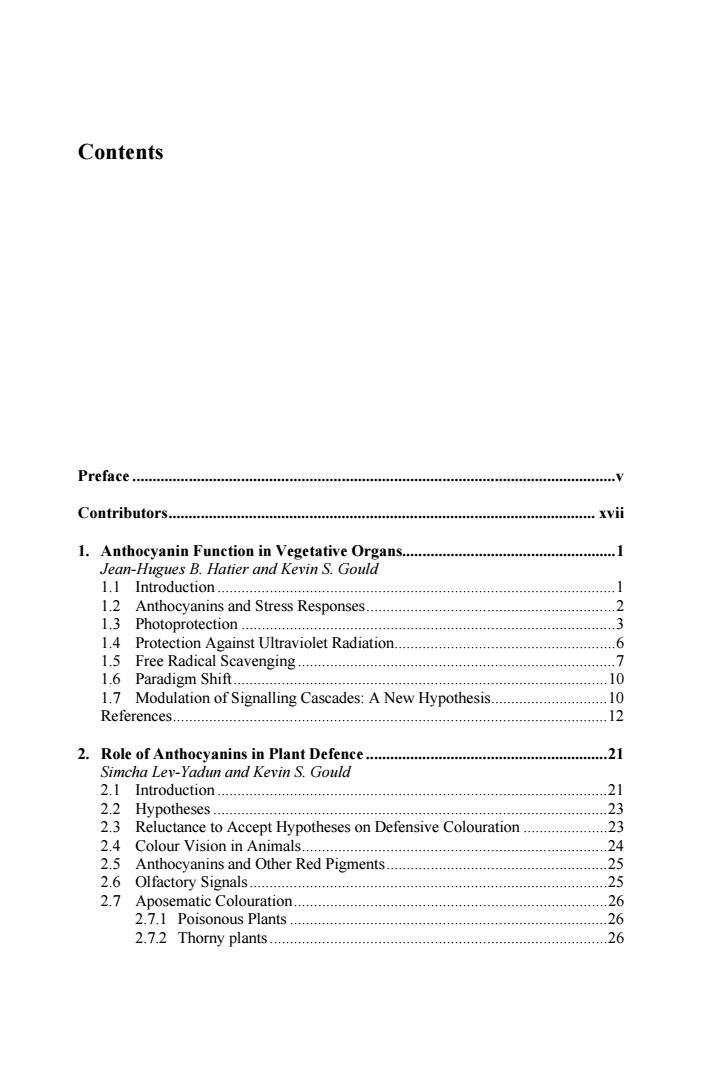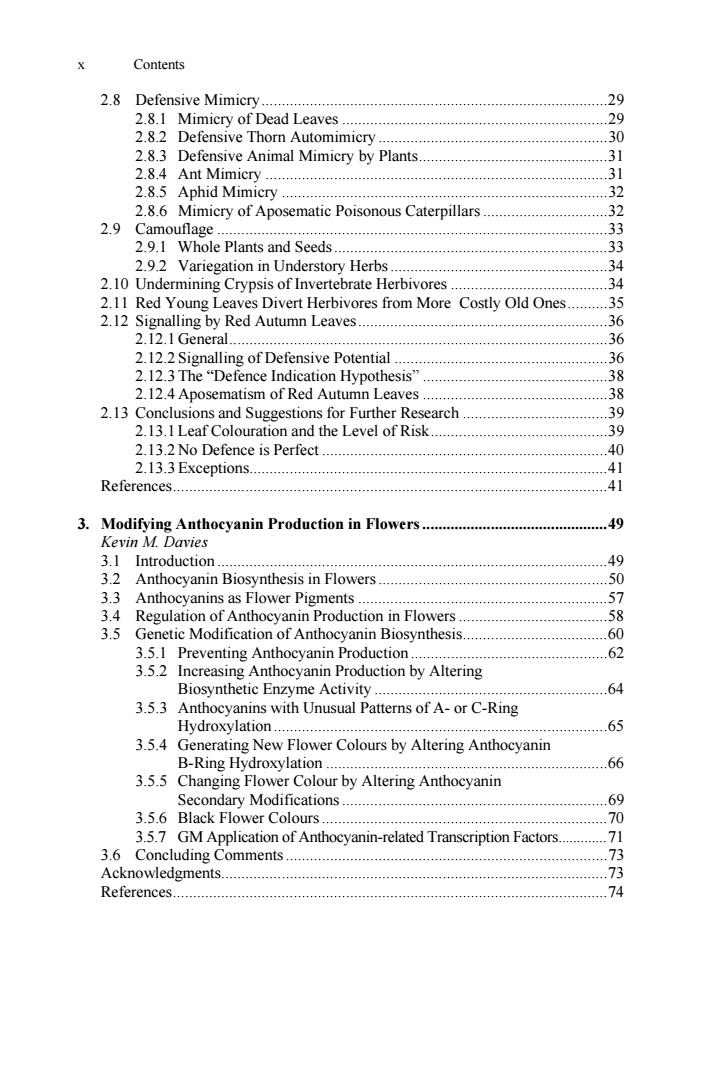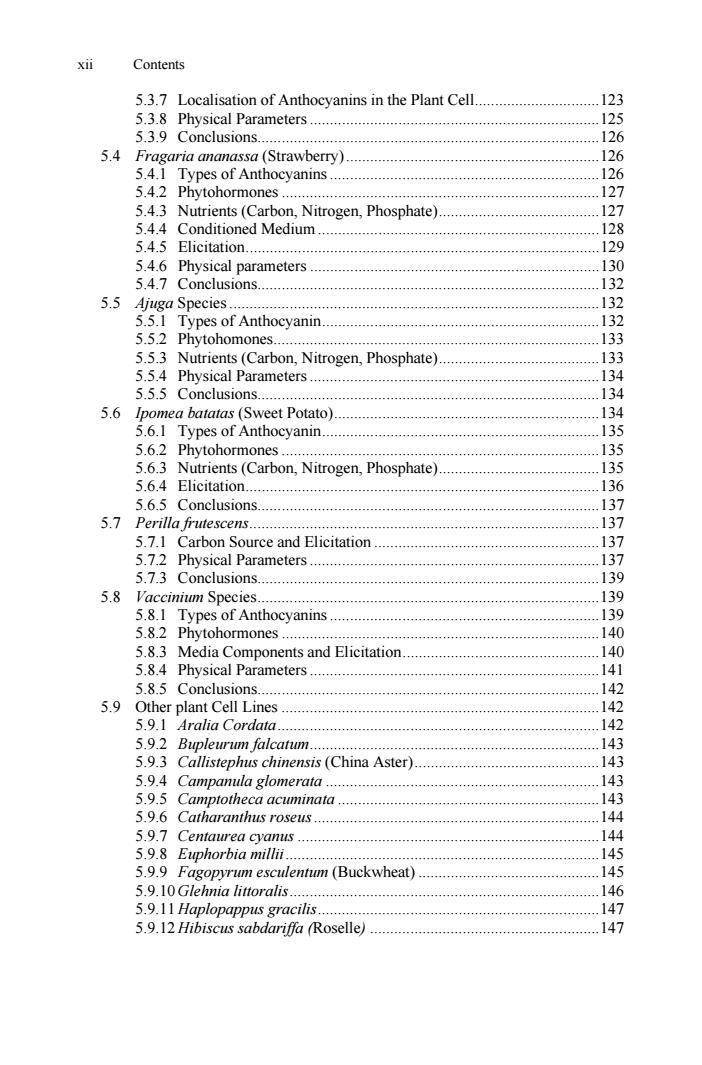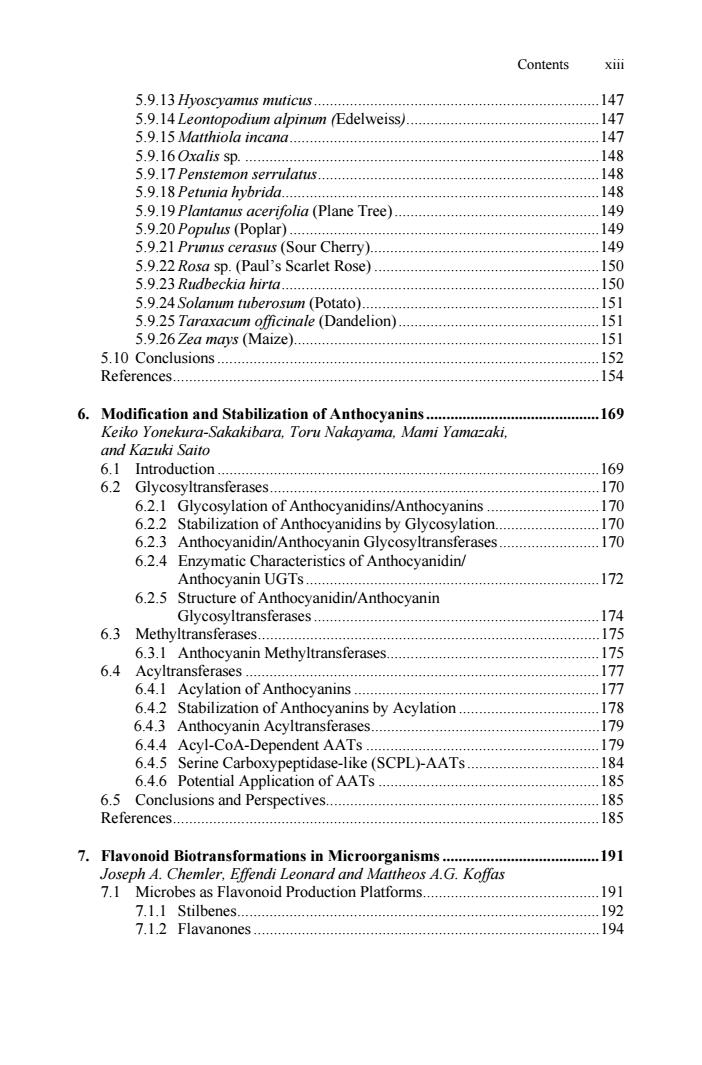
Contents Preface. Contributors.. ..xvii 1 Anthocvanin function in vegetative organs Jean-Hugues B.Hatier and Kevin S.Gould 1.1 Introduction. 12 Anthocvanins and Stress Responses. 13 Photoprotection」 1 4 Prote ction Ag nst ultraviolet radiation 15 16 Paradigm Shift 10 17 Modulatio n of Signalling Cascades:A New Hypothesis References. 2. 21 Le n and Kevin S.Gould 123 Hypotheses Reluctance to Accept Hypotheses on Defensive Colouration 2 Colour Vision in Animals Anthocyanins and Other Red Pigments.... 41 Olfactory Signals. 2 2.7 Aposematic Colouration.. 2.7.1 Poisonous Plants.... 2.7.2 Thorny plants.… ..26
Contents Preface ........................................................................................................................v Contributors.......................................................................................................... xvii 1. Anthocyanin Function in Vegetative Organs.....................................................1 Jean-Hugues B. Hatier and Kevin S. Gould 1.1 Introduction ...................................................................................................1 1.2 Anthocyanins and Stress Responses..............................................................2 1.3 Photoprotection .............................................................................................3 1.4 Protection Against Ultraviolet Radiation.......................................................6 1.5 Free Radical Scavenging ...............................................................................7 1.6 Paradigm Shift.............................................................................................10 1.7 Modulation of Signalling Cascades: A New Hypothesis.............................10 References............................................................................................................12 2. Role of Anthocyanins in Plant Defence ............................................................21 Simcha Lev-Yadun and Kevin S. Gould 2.1 Introduction .................................................................................................21 2.2 Hypotheses ..................................................................................................23 2.3 Reluctance to Accept Hypotheses on Defensive Colouration .....................23 2.4 Colour Vision in Animals............................................................................24 2.5 Anthocyanins and Other Red Pigments.......................................................25 2.6 Olfactory Signals.........................................................................................25 2.7 Aposematic Colouration..............................................................................26 2.7.1 Poisonous Plants ...............................................................................26 2.7.2 Thorny plants ....................................................................................26

Contents 2.8 Defensive Mimicry. 39 2.8.1 Mimicry of Dead Leaves.. .29 2.8.2 Defensive Thorn Automimicry 2.8.3 Defensive Animal Mimicry by Plants 31 2.8.4 Ant Mimicry.. 31 2.8.5 Aphid Mimicry 32 2.8.6 Mimicry of Aposematic Poisonous Caterpillars 32 2.9 Camouflage 33 2 9 1 Whole Plants and Seeds 33 2 9 2 variegation in Understory herbs 34 2.10 Undermining Crypsis of Invertebrate Herbivores 34 2.11 Red Young Leaves Divert Herbivores from More Costly Old Ones. 2.12 Signalling by Red Autumn Leaves 36 2 12 I General 36 2 12 2 Signalling of Defensive potential 16 2.12.3 The "Defence Indication Hypothesis" 2.12.4 Aposematism of Red Autumn Leaves 18 2.13 Conclus and Su for Further Research 10 2 13.1Leaf Coloura n and the level of risk 20 2 13.2No Defer ce is Perfec Ref rences 3.Modifyi .49 oductior .3 49 Anthocyanin Biosynthesis in Flowers Anthocyanins as Flower Pigments Regulation of Anthocyanin Production in Flowers Genetic Modification of Anthocyanin Biosynthesis.. .60 3.5.1 Preventing Anthocyanin Production. .62 3.5.2 Increasing Anthocyanin Production by Altering Biosynthetic Enzyme Activity... .6d 3.5.3 Anthocyanins with Unusual Patterns of A-or C-Ring Hvdroxvlation.. .65 3.5.4 Generating New Flower Colours by Altering Anthocyanin B-Ring Hydroxylation 66 3.5.5 Changing Flower Colour by Altering Anthocyanin Secondary Modifications. 69 3.5.6 Black Flower Colours. 70 3.5.7 GM Application of Anthocyanin-related Transcription Factors. 71 3.6 Concluding Comments 73 Acknowledgments.. 73 References. 74
x Contents 2.8 Defensive Mimicry......................................................................................29 2.8.1 Mimicry of Dead Leaves ..................................................................29 2.8.2 Defensive Thorn Automimicry .........................................................30 2.8.3 Defensive Animal Mimicry by Plants...............................................31 2.8.4 Ant Mimicry .....................................................................................31 2.8.5 Aphid Mimicry .................................................................................32 2.8.6 Mimicry of Aposematic Poisonous Caterpillars ...............................32 2.9 Camouflage .................................................................................................33 2.9.1 Whole Plants and Seeds....................................................................33 2.9.2 Variegation in Understory Herbs ......................................................34 2.10 Undermining Crypsis of Invertebrate Herbivores .......................................34 2.11 Red Young Leaves Divert Herbivores from More Costly Old Ones..........35 2.12 Signalling by Red Autumn Leaves..............................................................36 2.12.1 General..............................................................................................36 2.12.2 Signalling of Defensive Potential .....................................................36 2.12.3 The “Defence Indication Hypothesis” ..............................................38 2.12.4 Aposematism of Red Autumn Leaves ..............................................38 2.13 Conclusions and Suggestions for Further Research ....................................39 2.13.1 Leaf Colouration and the Level of Risk............................................39 2.13.2 No Defence is Perfect .......................................................................40 2.13.3 Exceptions.........................................................................................41 References............................................................................................................41 3. Modifying Anthocyanin Production in Flowers ..............................................49 Kevin M. Davies 3.1 Introduction .................................................................................................49 3.2 Anthocyanin Biosynthesis in Flowers .........................................................50 3.3 Anthocyanins as Flower Pigments ..............................................................57 3.4 Regulation of Anthocyanin Production in Flowers .....................................58 3.5 Genetic Modification of Anthocyanin Biosynthesis....................................60 3.5.1 Preventing Anthocyanin Production .................................................62 3.5.2 Increasing Anthocyanin Production by Altering Biosynthetic Enzyme Activity ..........................................................64 3.5.3 Anthocyanins with Unusual Patterns of A- or C-Ring Hydroxylation ...................................................................................65 3.5.4 Generating New Flower Colours by Altering Anthocyanin B-Ring Hydroxylation ......................................................................66 3.5.5 Changing Flower Colour by Altering Anthocyanin Secondary Modifications ..................................................................69 3.5.6 Black Flower Colours .......................................................................70 3.5.7 GM Application of Anthocyanin-related Transcription Factors.............71 3.6 Concluding Comments ................................................................................73 Acknowledgments................................................................................................73 References............................................................................................................74

Contents XI 4.Prevalence and Functions of Anthocyanins in Fruits .85 luction 85 43 Prevalence of Fruit Colours. 4 Distribution of Anthocyanins in Fruit 4. Environmental Regulation of Colour Development.. 4.5.1 Light. 4.5.2 Temperature 4.5.3 Other Factors. 9 4.6 Anthocyanins in Attraction. .,92 4.6.I Visual Svstems. 92 4.62 Red Fruits 95 4.6.3 Blue and Black Fruits 94 4.7 Fruit Quality and Composition .95 4.7.1 Health Benefits. .95 4.7.2 Nutritional Content and Defensive Strength .96 473 Maturity .97 4.8 Anthocyanin and Fruit Size 98 49 Photoprotection. 99 4.10 Perspectives. 99 References 100 5.Anthocyanin Biosynthesis in Plant Cell Cultures: A potential souree of natural colourants 107 Simon Deroles 5.1 Introduction 107 5.1.1 The Anth 10 5.1.2 Plant Cell Cult 52 D 111 52.1T 522 pes of Ar 523 erases from Carrot Cell Cultures 112 54 525 s(Carbon,Nitrogen,Phosphate) 526 ation 527 5.2.8 ght 529 Aggregate Size trategies for Enhanced Production of Anthocyanins. 5.3 Vitis vinifera (Grape). 118 5.3.1 Types of Anthocyanins. 5.32 Modification of Anthocyanins in Grape Cell Cultures 11y 5.33 Phytohormones 5.34 Nutrients (Carbon. Nitrogen,Phosphate).. .120 53.5 pH,Conditioned Media and Feeder Layers. 122 5.3.6 Elicitation and Light.. .122
Contents xi 4. Prevalence and Functions of Anthocyanins in Fruits .....................................85 W. J. Steyn 4.1 Introduction .................................................................................................85 4.2 Prevalence of Fruit Colours.........................................................................86 4.3 Developmental Patterns...............................................................................88 4.4 Distribution of Anthocyanins in Fruit..........................................................89 4.5 Environmental Regulation of Colour Development ....................................89 4.5.1 Light..................................................................................................90 4.5.2 Temperature......................................................................................90 4.5.3 Other Factors.....................................................................................91 4.6 Anthocyanins in Attraction..........................................................................92 4.6.1 Visual Systems..................................................................................92 4.6.2 Red Fruits..........................................................................................93 4.6.3 Blue and Black Fruits........................................................................94 4.7 Fruit Quality and Composition....................................................................95 4.7.1 Health Benefits .................................................................................95 4.7.2 Nutritional Content and Defensive Strength .....................................96 4.7.3 Maturity ............................................................................................97 4.8 Anthocyanin and Fruit Size.........................................................................98 4.9 Photoprotection ...........................................................................................98 4.10 Perspectives.................................................................................................99 References..........................................................................................................100 5. Anthocyanin Biosynthesis in Plant Cell Cultures: A Potential Source of Natural Colourants .....................................................107 Simon Deroles 5.1 Introduction ...............................................................................................107 5.1.1 The Anthocyanins...........................................................................107 5.1.2 Plant Cell Cultures..........................................................................109 5.2 Daucus carota (Carrot)..............................................................................111 5.2.1 Types of Anthocyanins ...................................................................111 5.2.2 Glucosyltransferases from Carrot Cell Cultures .............................111 5.2.3 Phytohormones ...............................................................................112 5.2.4 GA3 .................................................................................................113 5.2.5 Nutrients (Carbon, Nitrogen, Phosphate)........................................114 5.2.6 Elicitation........................................................................................115 5.2.7 Light................................................................................................116 5.2.8 Aggregate Size................................................................................117 5.2.9 Future Strategies for Enhanced Production of Anthocyanins .........117 5.3 Vitis vinifera (Grape).................................................................................118 5.3.1 Types of Anthocyanins ...................................................................119 5.3.2 Modification of Anthocyanins in Grape Cell Cultures ...................119 5.3.3 Phytohormones ...............................................................................119 5.3.4 Nutrients (Carbon, Nitrogen, Phosphate)........................................120 5.3.5 pH, Conditioned Media and Feeder Layers ....................................122 5.3.6 Elicitation and Light .......................................................................122

xii Contents 5.3.7 Localisation of Anthocyanins in the Plant Cell.. .123 5.3.8 Physical Parameters. ..125 539 Conclusions .126 5.4 Fragaria ananassa(Strawberry) 126 5.4.1 Types of Anthocyanins .126 5.4.2 Phytohormones 127 5.4.3 Nutrients(Carbon,Nitrogen,Phosphate) 127 544 Conditioned Medium 128 5 4 5 Elicitation 129 5 4 6 Physical parameters .130 54.7 Conclusions. 13 5.5 Aiuga species 132 5.5.1 Types of Anthocyanin. 13 132 5.5.3 Nutrients(Carbon,Nitrogen,Phosphate). 111 5 54 Physical Parameters 124 5.5.5 Conclusions 114 5.6 hatatas (Sweet Potato 134 561 T s of Anthocyanin 139 56) 135 ts (Carbon,Nitrogen,Phosphate) 139 56A 136 5.6.5c on 13 57 137 571 arbon S urce and Elicitation rameters. 5.7.3 5.8 ac ium Spe 582 ype 584 Media Components and Elicitation. 140 Physical Parameters .4 5.8.5 Conclusions. …142 5.9 Other plant Cell Lines .142 Aralia Cordata .142 5.92 Bupleurum falcatum. .143 5.9.3 Callistephus chinensis (China Aster).... ..143 5.9.4 Campanula glomerata .143 5.9.5 Camptotheca acuminata 143 5 9 6 Catharanthus roseus. 144 5.9.7 Centaurea cyanus. 144 5.9.8 Euphorbia millii ..145 5.9.9 Fagopyrum esculentum(Buckwheat) .45 5.9.10 Glehnia littoralis.. .146 5.9.11 Haplopappus gracilis. 147 5.9.12 Hibiscus sabdariffa (Roselle) .147
xii Contents 5.3.7 Localisation of Anthocyanins in the Plant Cell...............................123 5.3.8 Physical Parameters ........................................................................125 5.3.9 Conclusions.....................................................................................126 5.4 Fragaria ananassa (Strawberry)...............................................................126 5.4.1 Types of Anthocyanins ...................................................................126 5.4.2 Phytohormones ...............................................................................127 5.4.3 Nutrients (Carbon, Nitrogen, Phosphate)........................................127 5.4.4 Conditioned Medium ......................................................................128 5.4.5 Elicitation........................................................................................129 5.4.6 Physical parameters ........................................................................130 5.4.7 Conclusions.....................................................................................132 5.5 Ajuga Species ............................................................................................132 5.5.1 Types of Anthocyanin.....................................................................132 5.5.2 Phytohomones.................................................................................133 5.5.3 Nutrients (Carbon, Nitrogen, Phosphate)........................................133 5.5.4 Physical Parameters ........................................................................134 5.5.5 Conclusions.....................................................................................134 5.6 Ipomea batatas (Sweet Potato)..................................................................134 5.6.1 Types of Anthocyanin.....................................................................135 5.6.2 Phytohormones ...............................................................................135 5.6.3 Nutrients (Carbon, Nitrogen, Phosphate)........................................135 5.6.4 Elicitation........................................................................................136 5.6.5 Conclusions.....................................................................................137 5.7 Perilla frutescens.......................................................................................137 5.7.1 Carbon Source and Elicitation ........................................................137 5.7.2 Physical Parameters ........................................................................137 5.7.3 Conclusions.....................................................................................139 5.8 Vaccinium Species.....................................................................................139 5.8.1 Types of Anthocyanins ...................................................................139 5.8.2 Phytohormones ...............................................................................140 5.8.3 Media Components and Elicitation.................................................140 5.8.4 Physical Parameters ........................................................................141 5.8.5 Conclusions.....................................................................................142 5.9 Other plant Cell Lines ...............................................................................142 5.9.1 Aralia Cordata................................................................................142 5.9.2 Bupleurum falcatum........................................................................143 5.9.3 Callistephus chinensis (China Aster)..............................................143 5.9.4 Campanula glomerata ....................................................................143 5.9.5 Camptotheca acuminata .................................................................143 5.9.6 Catharanthus roseus.......................................................................144 5.9.7 Centaurea cyanus ...........................................................................144 5.9.8 Euphorbia millii..............................................................................145 5.9.9 Fagopyrum esculentum (Buckwheat) .............................................145 5.9.10 Glehnia littoralis.............................................................................146 5.9.11 Haplopappus gracilis......................................................................147 5.9.12 Hibiscus sabdariffa (Roselle) .........................................................147

Contents 147 is sp 148 Penstemon serrulatus 14 148 5.9.19 Plantans acerifolia(Plane Tree). .4 5.9.20 Populus (Poplar) .14 5.9.21 Prunus cerasus (Sour Cherry) .149 5.9.22 Rosa sp.(Paul's Scarlet Rose) .5 5.9.23 Rudbeckia hirta.. 5.9.24 Solanum tuberosum (Potato) 151 5.9.25 Taraxacum officinale (Dandelion) 15 5.9.26 Zea mays (Maize).. 151 5.10 Conclusions. .52 References 154 6.Modification and Stabilization of Anthocyanins .169 Keiko Yonekura-Sakakibara.Toru Nakavama.Mami Yamazaki and ka=uki Saito 6 1 Introduction 16q 6.2 170 vanidins/Anthocvanins 170 6)) Stabilization of anthocyanidins by Glycosylation 17d 6.2.3 Anthocyanidin/Anthocyanin Glycosyltransferases 170 natic Characteristics of antho vanidin A nth 172 6.2.5 ctur e of Anth yanidin/Anthocyanin ans 174 6.3 Methyltra 179 631 nin Methyltransferases 6.4 lati of Anthocyanins 177 yanins by Acylation cyanin Acyl 6.4.4 64 Acyl-CoA Depende ine oxypeptid (SCPL)-AATs 77788 6.4.6 Potentia n o of AAT 6.5 Conc usions and Perspectives References. 7.Flavonoid Biotransformations in Microorganisms. .191 Joseph A.Chemler.Effendi Leonard and Mattheos A.G.Koffas 7.1 Microbes as Flavonoid Production Platforms.. 191 7.1.I Stilbenes. .192 7.1.2 Flavanones .194
Contents xiii 5.9.13 Hyoscyamus muticus.......................................................................147 5.9.14 Leontopodium alpinum (Edelweiss)................................................147 5.9.15 Matthiola incana.............................................................................147 5.9.16 Oxalis sp. ........................................................................................148 5.9.17 Penstemon serrulatus......................................................................148 5.9.18 Petunia hybrida...............................................................................148 5.9.19 Plantanus acerifolia (Plane Tree)...................................................149 5.9.20 Populus (Poplar) .............................................................................149 5.9.21 Prunus cerasus (Sour Cherry).........................................................149 5.9.22 Rosa sp. (Paul’s Scarlet Rose) ........................................................150 5.9.23 Rudbeckia hirta...............................................................................150 5.9.24 Solanum tuberosum (Potato)...........................................................151 5.9.25 Taraxacum officinale (Dandelion)..................................................151 5.9.26 Zea mays (Maize)............................................................................151 5.10 Conclusions ...............................................................................................152 References..........................................................................................................154 6. Modification and Stabilization of Anthocyanins ...........................................169 Keiko Yonekura-Sakakibara, Toru Nakayama, Mami Yamazaki, and Kazuki Saito 6.1 Introduction ...............................................................................................169 6.2 Glycosyltransferases..................................................................................170 6.2.1 Glycosylation of Anthocyanidins/Anthocyanins ............................170 6.2.2 Stabilization of Anthocyanidins by Glycosylation..........................170 6.2.3 Anthocyanidin/Anthocyanin Glycosyltransferases.........................170 6.2.4 Enzymatic Characteristics of Anthocyanidin/ Anthocyanin UGTs .........................................................................172 6.2.5 Structure of Anthocyanidin/Anthocyanin Glycosyltransferases .......................................................................174 6.3 Methyltransferases.....................................................................................175 6.3.1 Anthocyanin Methyltransferases.....................................................175 6.4 Acyltransferases ........................................................................................177 6.4.1 Acylation of Anthocyanins .............................................................177 6.4.2 Stabilization of Anthocyanins by Acylation ...................................178 6.4.4 Acyl-CoA-Dependent AATs ..........................................................179 6.4.5 Serine Carboxypeptidase-like (SCPL)-AATs .................................184 6.4.6 Potential Application of AATs .......................................................185 6.5 Conclusions and Perspectives....................................................................185 References..........................................................................................................185 7. Flavonoid Biotransformations in Microorganisms .......................................191 Joseph A. Chemler, Effendi Leonard and Mattheos A.G. Koffas 7.1 Microbes as Flavonoid Production Platforms............................................191 7.1.1 Stilbenes..........................................................................................192 7.1.2 Flavanones ......................................................................................194 6 .4. 3 Anthocyanin Acyltransferases.........................................................179